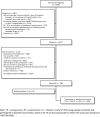Demographic, clinical, and service-use characteristics related to the clinician's recommendation to transition from child to adult mental health services
- PMID: 35146551
- PMCID: PMC9042957
- DOI: 10.1007/s00127-022-02238-6
Demographic, clinical, and service-use characteristics related to the clinician's recommendation to transition from child to adult mental health services
Abstract
Purpose: The service configuration with distinct child and adolescent mental health services (CAMHS) and adult mental health services (AMHS) may be a barrier to continuity of care. Because of a lack of transition policy, CAMHS clinicians have to decide whether and when a young person should transition to AMHS. This study describes which characteristics are associated with the clinicians' advice to continue treatment at AMHS.
Methods: Demographic, family, clinical, treatment, and service-use characteristics of the MILESTONE cohort of 763 young people from 39 CAMHS in Europe were assessed using multi-informant and standardized assessment tools. Logistic mixed models were fitted to assess the relationship between these characteristics and clinicians' transition recommendations.
Results: Young people with higher clinician-rated severity of psychopathology scores, with self- and parent-reported need for ongoing treatment, with lower everyday functional skills and without self-reported psychotic experiences were more likely to be recommended to continue treatment. Among those who had been recommended to continue treatment, young people who used psychotropic medication, who had been in CAMHS for more than a year, and for whom appropriate AMHS were available were more likely to be recommended to continue treatment at AMHS. Young people whose parents indicated a need for ongoing treatment were more likely to be recommended to stay in CAMHS.
Conclusion: Although the decision regarding continuity of treatment was mostly determined by a small set of clinical characteristics, the recommendation to continue treatment at AMHS was mostly affected by service-use related characteristics, such as the availability of appropriate services.
Keywords: Adult mental health services; Child and adolescent mental health services; Transition; Young adults.
© 2022. The Author(s).
Conflict of interest statement
The MILESTONE project was funded by EU FP7 programme under grant number 602442. SPS is part-funded by the National Institute for Health Research (NIHR) Collaboration for Leadership in Applied Health Research and Care West Midlands (NIHR CLAHRC WM), now recommissioned as NIHR Applied Research Collaboration West Midlands. The views expressed in this publication are those of the author(s) and not necessarily those of the NIHR or the Department of Health and Social Care. PS is the co-inventor of the HealthTrackerTM and is the Chief Executive Officer and shareholder in HealthTracker Ltd. FF is a Chief Technical Officer and AK is the Chief Finance Officer employed by HealthTracker Ltd, respectively. FCV publishes the Dutch translations of ASEBA, from which he receives remuneration. AM was a speaker and advisor for Neurim, Shire, Infectopharm, and Lilly (all not related to transition research).
References
-
- McGorry PD. The specialist youth mental health model: strengthening the weakest link in the public mental health system. Med J Aust. 2007;187(7 Suppl):S53–56. - PubMed
-
- Islam Z, Ford T, Kramer T, Paul M, Parsons H, Harley K, Weaver T, McLaren S, Singh SP. Mind how you cross the gap! Outcomes for young people who failed to make the transition from child to adult services: the TRACK study. BJPsych Bull. 2016;40(3):142–148. doi: 10.1192/pb.bp.115.050690. - DOI - PMC - PubMed
MeSH terms
Grants and funding
LinkOut - more resources
Full Text Sources
Medical


